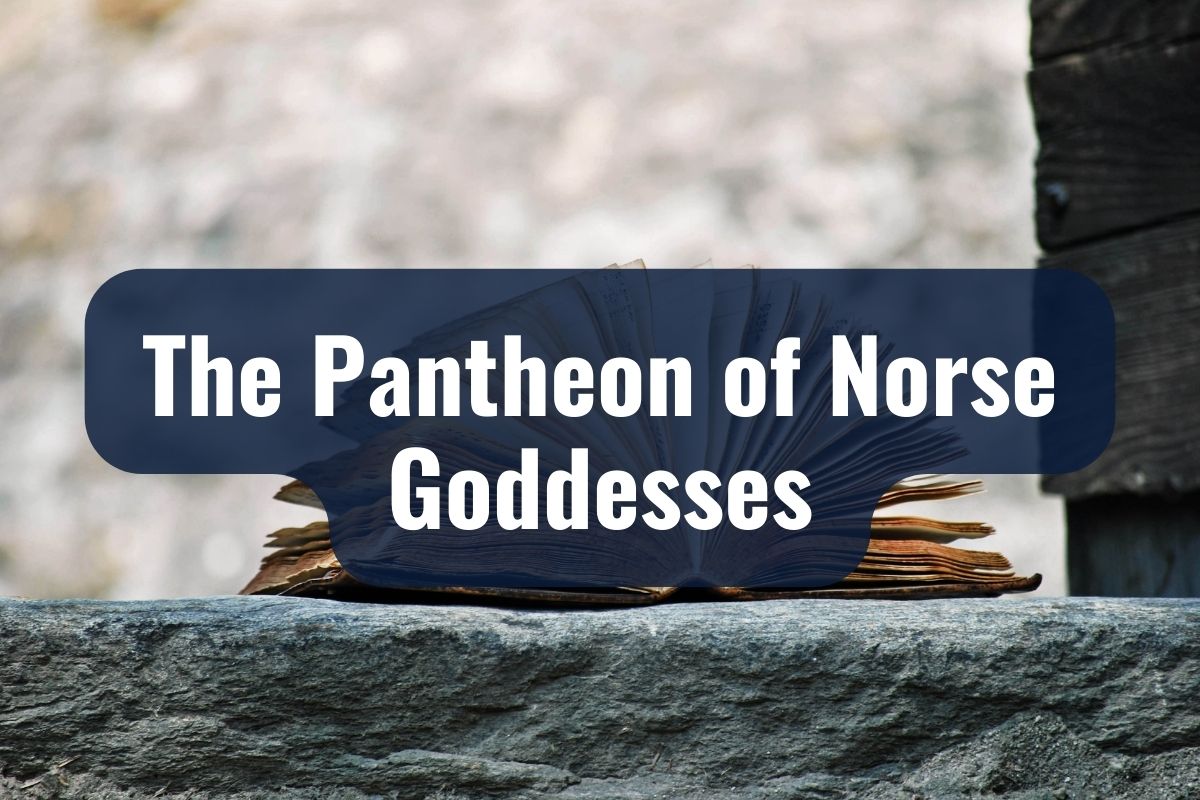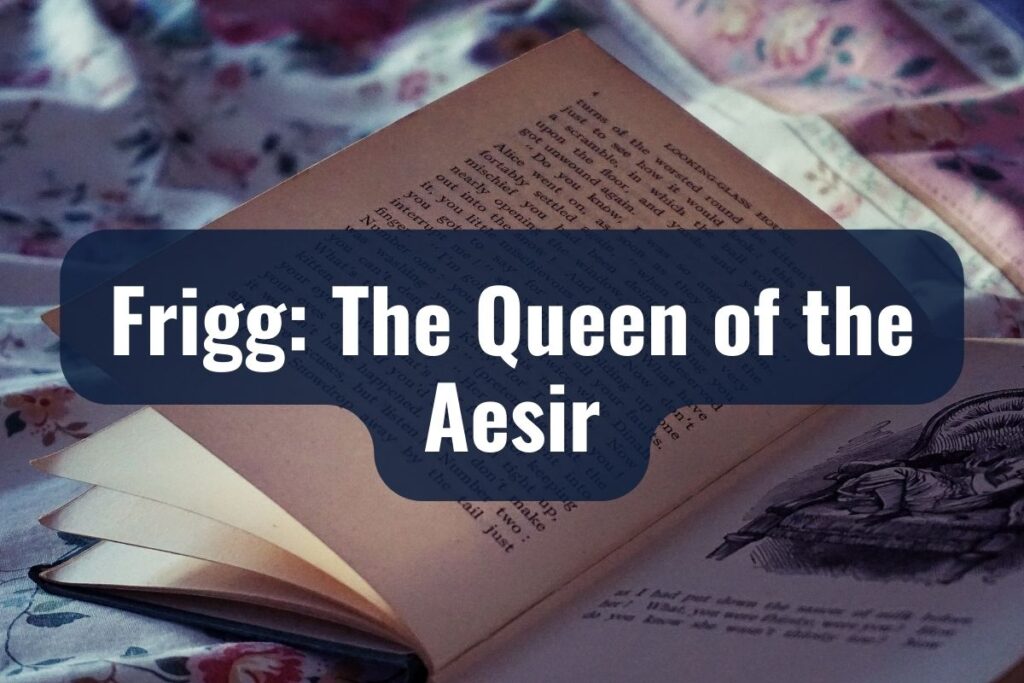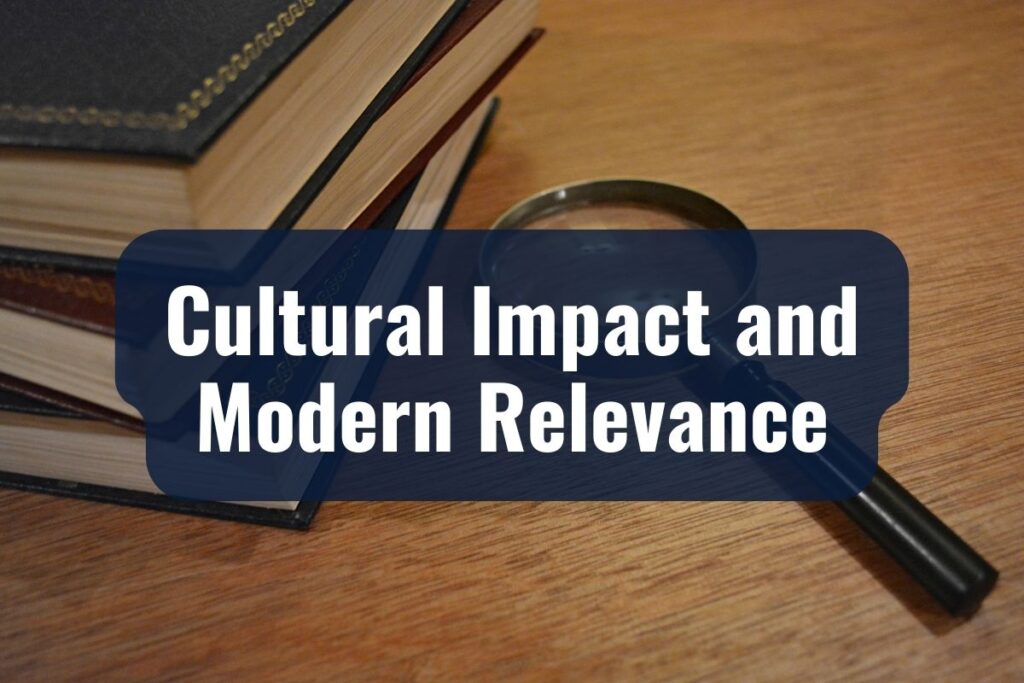Norse mythology forms a cornerstone of Scandinavian cultural heritage. Originating from the early medieval Scandinavian Norsemen, these myths were initially conveyed orally, passing down tales of gods, goddesses, and heroes through generations. It wasn’t until the 13th century that these stories were finally penned down, primarily in the ‘Poetic Edda’ and the ‘Prose Edda’.
As we delve into the world of Norse goddesses, we will explore not only their legendary tales but also the profound cultural and spiritual significance these figures hold in Norse mythology.
Key Takeaways
- Norse mythology’s goddesses are pivotal, embodying unique aspects of life and human emotion.
- Freyja, goddess of love and war, symbolizes the duality of beauty and fierceness.
- Frigg, the Aesir queen, represents wisdom, foresight, and maternal strength.
- Skadi, goddess of winter and hunting, reflects nature’s harshness and resilience.
- Idunn, guardian of the rejuvenating apples, symbolizes youth and natural cycles.
- Lesser-known goddesses like Sif, Hel, and Gerd enrich Norse mythology with diverse themes.
The Essence of Norse Mythology
At the heart of these sagas are the gods and goddesses of the Norse pantheon, each embodying unique aspects of life, nature, and human emotion.
Unlike many other mythological traditions, Norse gods and goddesses are portrayed as powerful yet fallible beings, often reflecting the everyday struggles and triumphs of human existence. Their tales are not just stories but reflections of the values, fears, and aspirations of the Norse people.
Significance of Goddesses in Norse Myths
In this realm of divine beings, goddesses hold positions of great esteem and influence. Their roles extend far beyond mere companions to the gods; they are pivotal characters with their unique powers, responsibilities, and narratives.
From Freyja, the goddess of love and war, to Frigg, the wise queen of the Aesir, each goddess has her distinct story, weaving her essence into the fabric of Norse cosmology.
These goddesses are not just emblematic of various aspects of life, such as love, fertility, wisdom, and death, but also of the societal values and the spiritual beliefs of the Norse people. They are celebrated for their strength, wisdom, and complexity, offering a multifaceted view of femininity that is both empowering and enlightening.
The Pantheon of Norse Goddesses

Norse mythology presents a captivating ensemble of deities, each playing a crucial role in the cosmic narrative of the Norse people. Central to this mythological framework are the goddesses, who stand not merely as counterparts to their male counterparts but as sovereign figures with their domains, powers, and stories.
| Goddess | Domain | Key Attributes | Notable Myths |
| Freyja | Love, Beauty, War, and Fertility | Dual-natured, Beauty, Fierce Warrior | Leader of Valkyries, Brísingamen tale |
| Frigg | Marriage, Motherhood, Foresight | Wisdom, Foresight, Maternal Strength | Protecting Baldr, Queen of Aesir |
| Skadi | Winter, Mountains, Hunting | Resilience, Independence, Strength | Marriage to Njord, Winter symbolism |
| Idunn | Youth, Rejuvenation, Fertility | Youthfulness, Renewal, Guardian of Apples | Abduction and rescue, Sustaining gods |
Aesir and Vanir: The Two Tribes
The Norse deities are primarily divided into two tribes: the Aesir and the Vanir. This division is not just a categorization, but a reflection of the diverse aspects of life and nature that these deities oversee.
The Aesir, residing in Asgard, are often associated with power, war, and governance. Meanwhile, the Vanir, hailing from Vanaheim, symbolizes aspects of fertility, prosperity, and the natural world.
Goddesses of the Aesir
The Aesir tribe boasts some of the most renowned goddesses in Norse mythology. Foremost among them is Frigg, the wife of Odin and the queen of Asgard.
She is revered as a goddess of marriage, motherhood, and domestic affairs, embodying the ideals of wisdom and foresight. Another prominent figure is Sif, known for her golden hair and associated with earth and fertility.
Goddesses of the Vanir
The Vanir goddesses, though fewer in number, are equally significant. Freyja, perhaps the most famous of the Vanir goddesses, is a complex deity embodying love, beauty, fertility, war, and death. She is known for her fierce independence and magical prowess, particularly in seidr, a form of Norse magic.
The Roles and Stories of Goddesses
Each goddess in the Norse pantheon has her unique narrative and domain. Their stories are not just mythological tales but are imbued with symbolic meanings and insights into the Norse worldview.
These goddesses often play pivotal roles in the events of the Norse mythological universe, from the creation of the world to the prophesied end, Ragnarök.
Freyja: The Goddess of Love and War
In the realm of Norse mythology, Freyja stands out as a goddess of remarkable complexity and influence. Known for her unparalleled beauty and fierce warrior spirit, Freyja’s character transcends the conventional boundaries of love and battle, embodying a powerful amalgamation of both.
Goddess of Love and Fertility
Freyja, often hailed as the most beautiful among the goddesses, is primarily associated with love, beauty, and fertility. Her domain extends over the aspects of romance, attraction, and childbirth, making her a figure of reverence and appeal, especially among those seeking love or desiring offspring.
Her connection with fertility is not limited to humans alone but encompasses the earth’s fertility, highlighting her integral role in the natural and life cycles.
Warrior and Leader of the Valkyries
Contrasting her role as a deity of love and beauty, Freyja is also a formidable warrior and leader of the Valkyries. In this capacity, she rides into battle, choosing half of the slain warriors to reside in her hall, Sessrúmnir, in the afterlife realm of Fólkvangr.
This aspect of her character underlines a theme prevalent in Norse mythology: the coexistence of life and death, beauty and battle, love and strife.
Freyja’s Mythology and Symbolism
Freyja is often depicted with her sacred animals, including cats that draw her chariot and a boar named Hildisvíni. These animals are not mere companions; they are potent symbols of her divine powers and attributes.
The cats, often seen as creatures of mystery and sensuality, accentuate Freyja’s connections with love and magic, while the boar, a symbol of strength and protection, echoes her warlike aspect.
Her Role in Norse Tales
Freyja features prominently in various Norse tales, showcasing her multifaceted nature. One such story is her unyielding search for her missing husband, Óðr, a tale that paints her as a goddess not just of physical love, but of deep, unwavering emotional bonds.
Another notable legend involves her possession of the Brísingamen, a magnificent necklace, symbolizing her immense beauty and the lengths she would go to protect and enhance her attributes.
Freyja’s complexities make her an intriguing and significant figure in Norse mythology. She embodies the seamless integration of seemingly opposing forces—love and war, fertility and death—showcasing the intricate and multifaceted nature of life itself.
Her stories and symbols offer profound insights into the Norse understanding of the divine feminine, highlighting strength, autonomy, and depth. As we continue to explore the fascinating world of Norse goddesses, Freyja stands as a testament to the rich, nuanced characterizations these ancient myths offer.
Frigg: The Queen of the Aesir

Frigg, the esteemed queen of the Aesir and wife of Odin, holds a place of high honor in Norse mythology. Known for her wisdom, foresight, and maternal attributes, Frigg stands as a symbol of sovereignty, prophecy, and domesticity. Her character embodies the ideals of motherhood, marital fidelity, and the preserver of the household’s harmony and welfare.
The Role and Powers of Frigg
As the queen of Asgard, Frigg is often portrayed as a dignified and compassionate figure, the epitome of maternal grace and wisdom. She is revered as a protector of marriages and families, often invoked for matters concerning childbirth and domestic well-being.
Her presence in the mythological narratives often brings a sense of calm and order, showcasing her as a stabilizing force among the often tumultuous lives of the gods.
Goddess of Foresight and Wisdom
One of Frigg’s most remarkable attributes is her ability to see into the future, though she seldom reveals what she knows. This power of foresight positions her as a deity of wisdom and deep understanding, not only of fate but also of human nature and the complexities of the divine realm.
Her wisdom is not just limited to knowledge but extends to practical skills, particularly in the art of weaving, which metaphorically ties her to the weaving of fates and destinies.
Frigg in Norse Myths
Frigg features in several Norse myths where her influence is felt, even if she is not always at the forefront of the action. One poignant tale involves her efforts to protect her beloved son, Baldr.
She exacts promises from all things in the world not to harm him, highlighting her maternal devotion and her proactive approach to her foresight. Despite her efforts, Baldr’s eventual death underlines the theme of inescapable fate, a central tenet in Norse belief.
Symbolism and Cultural Impact
Frigg’s character offers rich symbolism, particularly in the context of Norse culture. She represents the ideal of the Norse matriarch: wise, protective, and deeply connected to the well-being of her family and realm.
Her role transcends the domestic sphere, influencing the cosmic order and the fates of gods and mortals alike. In modern times, Frigg continues to symbolize maternal strength, wisdom, and the complexities of womanhood, resonating with contemporary values and beliefs.
As the Queen of the Aesir, Frigg’s persona intertwines the roles of a nurturing mother, a wise counselor, and a powerful goddess. Her presence in Norse mythology brings depth and perspective to the Norse pantheon, showcasing the multifaceted nature of the divine feminine.
Through her stories and attributes, we gain a deeper understanding of the values, beliefs, and social structures of the ancient Norse people, where goddesses like Frigg were revered not just for their divine status but for the profound wisdom and balance they brought to the Norse cosmological narrative.
Skadi: The Goddess of Winter and the Hunt
Skadi, a unique and formidable figure in Norse mythology, stands as the embodiment of winter’s harshness and the thrill of the hunt. As a giantess who became a goddess through her marriage to the god Njord, Skadi’s tale is one of resilience, independence, and a deep connection to the natural world.
The Nature and Attributes of Skadi
Skadi as the Winter Goddess
Skadi’s association with winter is profound. She personifies the stark, unforgiving beauty of the snowy landscapes, the resilience required to survive the harsh Nordic winters, and the silent majesty of the snow-covered mountains.
Her character is often depicted as tough, self-reliant, and unyielding, much like the winter itself. In her, we see the embodiment of the natural cycle, where the harshness of winter is necessary for the renewal of spring.
The Huntress Supreme
Apart from her winter aspects, Skadi is revered as a skilled huntress, adept in the ways of the wilderness. Her prowess in hunting, particularly with the bow and arrow, marks her as a symbol of survival, agility, and the predatory aspects of nature.
Her connection with hunting extends beyond the mere act of the hunt to a deeper understanding and respect for the natural order and the cycle of life and death.
Skadi’s Role in Norse Mythology
Her Marriage to Njord
Skadi’s most notable myth involves her marriage to Njord, the sea god, an arrangement born out of compromise and reparations. Their union, representing the union of the mountain and the sea, is a poignant reflection of the Norse understanding of balance and harmony in nature, despite their eventual separation due to incompatible preferences for the mountains and the sea.
Symbolism and Legacy
Skadi’s presence in Norse mythology brings forth themes of independence, strength, and the profound connection between the natural world and the divine. Her character challenges traditional roles, showcasing a goddess who is not only self-sufficient but also fiercely autonomous.
In modern interpretations, Skadi is often seen as a figure of empowerment, representing the untamed aspects of nature and the spirit of adventure and survival.
As the Goddess of Winter and the Hunt, Skadi adds a rich and compelling dimension to the Norse pantheon. Her stories encapsulate the respect and awe the Norse felt toward the natural world and its cycles.
Skadi’s character offers valuable insights into the ancient Norse worldview, where the divine was inextricably linked with the elemental forces of nature and where goddesses like Skadi were revered for their strength, independence, and deep connection to the earth and its seasons.
Idunn: The Keeper of the Apples of Youth

In the pantheon of Norse deities, Idunn stands as a unique and vital figure. As the keeper of the magical apples of youth, her role in Norse mythology is both central and symbolic, representing rejuvenation, renewal, and the sustaining power of nature.
The Essence and Duties of Idunn
Guardian of Youth and Vitality
Idunn’s primary responsibility is the care of the mystical apples that grant the gods their eternal youth and vigor. This duty places her at the heart of the gods’ well-being, highlighting her as a figure of immense importance.
Her role goes beyond mere guardianship; she symbolizes the very essence of youth, growth, and the rejuvenating power of nature. Through her, the cycle of life and renewal is continually maintained, reflecting the Norse belief in the cyclical nature of existence.
The Symbol of Fertility and Spring
Idunn is often associated with spring and renewal. Her connection with the apples of youth aligns her with the themes of regeneration and the revitalizing power of nature.
As the embodiment of these qualities, Idunn is revered as a nurturing presence, essential to the continuity and vitality of both the gods and the natural world.
Idunn in Norse Mythology
The Tale of Her Abduction
One of the most significant myths involving Idunn is the tale of her abduction by the giant Thjazi. Lured away from Asgard with a ruse, her absence causes the gods to age rapidly, highlighting the crucial nature of her role.
The rescue of Idunn by Loki, resulting in the return of the apples and the rejuvenation of the gods, underlines the theme of interdependence among the deities and the cyclical nature of renewal and decay.
Cultural Resonance and Interpretation
Idunn’s narrative resonates beyond its mythological context, offering insights into the Norse understanding of life, aging, and the natural order. She embodies the hope for renewal and the perennial nature of life’s vitality.
In contemporary interpretations, Idunn is often seen as a symbol of enduring youthfulness, not just in a physical sense but as a metaphor for the spirit’s perpetual capacity for growth and rejuvenation.
As the Keeper of the Apples of Youth, Idunn holds a unique and enchanting place in Norse mythology. Her story and attributes encapsulate the interconnectedness of life, the cycles of nature, and the eternal dance of aging and renewal.
Through Idunn, Norse mythology conveys profound truths about the natural world, the passage of time, and the ever-present possibility of rejuvenation and new beginnings. Her presence in the Norse pantheon underscores the rich tapestry of themes and symbols that these ancient myths embody, offering timeless wisdom and insight.
Lesser-Known Goddesses and Their Stories
Norse mythology is replete with a variety of goddesses, each contributing to the rich tapestry of tales and legends. Beyond the well-known deities like Freyja and Frigg, there are several lesser-known goddesses whose stories and attributes are equally fascinating and significant.
Sif: The Goddess of Earth and Fertility
The Golden-Haired Deity
Sif, primarily known for her lustrous golden hair, is a goddess associated with earth and fertility. Her hair, often interpreted as a symbol of golden wheat, links her to the abundance of the earth and agricultural prosperity. Sif’s role in mythology underscores the importance of the earth’s fertility in Norse culture, embodying the nourishment and sustenance provided by the land.
The Tale of Her Shorn Hair
One of Sif’s most notable myths involves Loki cutting off her beautiful hair. The loss and subsequent restoration of her hair, through the craftsmanship of the dwarves, not only highlights her resilience but also symbolizes the cyclical nature of growth and renewal inherent in agriculture and nature.
Hel: The Goddess of the Underworld
Ruler of the Dead
Hel, the goddess of the underworld, presides over the realm of the same name, where she oversees those who died of sickness or old age. Her domain is not a place of torment but a reflection of the Norse concept of death as an integral part of life’s cycle. Hel’s character is often misunderstood; she is a solemn and fair ruler, ensuring the continuation of life beyond death.
Symbolism of Death and Transition
Hel represents the inevitability of death and the transition from life to the afterlife. Her role in Norse myths brings forth the idea that death is a natural part of the life cycle, not something to be feared but to be accepted as a necessary transition.
Gerd: A Goddess of Beauty and Desire
The Etin Bride of Freyr
Gerd, a giantess of unparalleled beauty, becomes the wife of the god Freyr, symbolizing the union of the divine and the primordial forces of nature. Her story is one of desire and the lengths to which the gods would go to attain what they desire.
Representation of Fertility and Attraction
Gerd, through her marriage to Freyr, becomes associated with fertility, growth, and the bountiful aspects of the earth. Her narrative underlines the themes of attraction, the power of beauty, and the interconnectedness of all elements of nature.
These lesser-known goddesses, though not as prominently featured as others in the pantheon, play crucial roles in the Norse mythological universe. Each goddess brings a unique perspective and set of attributes to the stories, from Sif’s connection to the earth’s abundance, Hel’s solemn rulership over the dead, to Gerd’s embodiment of beauty and desire.
Their tales enrich the Norse mythological landscape, offering deeper insights into the ancient Norse worldview, where every aspect of life and nature was imbued with divine significance.
Cultural Impact and Modern Relevance

The Norse goddesses, with their rich narratives and diverse characteristics, have left a lasting impact on culture and continue to be relevant in modern times. Their stories, transcending the confines of ancient mythology, resonate with contemporary themes of empowerment, nature, and the human condition.
Influence on Literature and Popular Culture
Inspiration for Creative Works
Norse goddesses have been a source of inspiration in various forms of literature, art, and media. Their tales have been reimagined in novels, poetry, and artworks, often highlighting their strength, complexity, and the timeless nature of their stories.
In popular culture, these goddesses have found a new life, featuring prominently in movies, television series, and video games, reaching a broad and diverse audience, and sparking renewed interest in Norse mythology.
Symbolism in Modern Narratives
The attributes and tales of Norse goddesses, from Freyja’s duality of love and war to Frigg’s wisdom, have been integrated into modern storytelling, often serving as symbols of various aspects of the human experience. They represent a spectrum of qualities—resilience, independence, and nurturing—that continue to be relevant and inspiring.
The Role in Contemporary Paganism and Spirituality
Reverence in Neo-Pagan Practices
In contemporary pagan practices, particularly in Asatru and other forms of Heathenry, Norse goddesses hold a place of reverence. Modern practitioners often draw on the qualities and stories of these goddesses, finding spiritual significance and guidance in their ancient myths. Rituals and celebrations are held in their honor, keeping their presence and influence alive in spiritual communities.
Symbols of Feminine Strength and Diversity
The Norse goddesses, with their varied roles and attributes, have become symbols of feminine strength and diversity. They challenge the conventional archetypes of femininity, offering more complex and empowering representations of women. In a world increasingly conscious of gender roles and equality, these goddesses provide a rich source of inspiration and reflection.
Environmental Connections and Relevance
Guardians of Nature and Balance
Given their deep connection with natural elements—from Skadi’s dominion over winter to Idunn’s guardianship of rejuvenation—Norse goddesses resonate with current environmental concerns. They remind us of the importance of respecting and maintaining a balance with nature, a message that is increasingly pertinent in the face of global environmental challenges.
The cultural impact and modern relevance of Norse goddesses are profound and far-reaching. They continue to inspire, teach, and resonate with people across the world, transcending their mythological origins.
In a contemporary context, these goddesses serve as reminders of our past, guides for the present, and inspirations for the future, illustrating the enduring power and relevance of mythology in understanding and navigating the human experience.
Closing Remarks
As we conclude our exploration of Norse goddesses, it is evident that these divine figures are much more than just characters in ancient myths. They embody a rich tapestry of meanings, values, and insights into the human and the divine, resonating through centuries to reach us in the modern world.
The stories of Freyja, Frigg, Skadi, Idunn, and other lesser-known goddesses illustrate the complexity, strength, and multifaceted nature of the divine feminine in Norse mythology. These goddesses, with their unique attributes and narratives, not only reflect the beliefs and values of the ancient Norse people but also speak to us today.
They represent various aspects of life, from love and war to wisdom and nature, reminding us of the timeless and universal themes that continue to shape our understanding of the world. In a broader sense, their stories encourage a deeper appreciation for mythology and its role in shaping cultures, traditions, and worldviews.
As interest in Norse mythology grows in contemporary society, these goddesses stand as symbols of empowerment, natural harmony, and the enduring spirit of human storytelling. They inspire us to look beyond the surface of these ancient tales to find wisdom, inspiration, and a deeper connection to our past.
We hope that this journey through the mystique of Norse goddesses has been enlightening and engaging, offering not only knowledge but also a newfound appreciation for these powerful figures of mythology. May their stories continue to captivate, inspire, and guide us, just as they have done for generations before.
Resources for Further Exploration
Norse-Mythology.org – A comprehensive website offering detailed articles, interpretations, and discussions on Norse mythology, including the goddesses.
The Viking Network – An educational site providing information on Viking history and Norse myths.
Heathenry & Asatru Resources – Websites and online communities dedicated to modern Heathenry and Asatru practices, often discussing the roles and reverence of Norse goddesses in contemporary spirituality.
The National Museum of Denmark, Copenhagen – Houses an extensive collection of Viking artifacts and provides insights into Norse mythology and culture.
The Viking Ship Museum, Oslo – While focused on Viking ships, it also offers a glimpse into the broader Norse world, including religious beliefs and practices.


